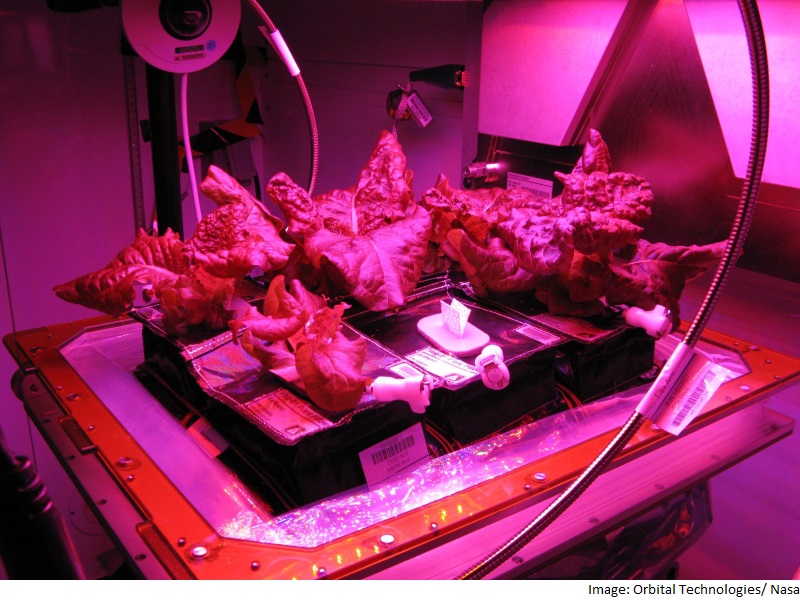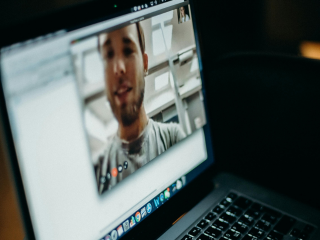- Home
- Science
- Science News
- ISS Astronauts Say First Bite of Space Grown Lettuce Is 'Awesome'
ISS Astronauts Say First Bite of Space-Grown Lettuce Is 'Awesome'

"That's awesome," exclaimed Nasa astronaut Kjell Lindgren, after he ate a piece of red romaine lettuce that was grown in a special box aboard the orbiting outpost.
"Tastes good," agreed astronaut Scott Kelly, who is spending one year at the research outpost.
"Kind of like arugula," Kelly added, then used a small bottle to spread olive oil and balsamic vinegar on his leaf, much as one might spread ketchup on a hot dog.
If space explorers can grow their own food while they are away from the Earth, Nasa says they are more likely to survive the rigors of deep space exploration lasting months or even years.
With no way to resupply a spacecraft making a long journey to and from Mars, the ability to cultivate food during the trip will be key to survival, said Kelly.
"Having the ability to grow our own food is a big step in that direction," he said.
Ray Wheeler, Nasa's lead scientist for advanced life support activities at Kennedy Space Center in Florida, also said fresh foods that contain antioxidants, such as tomatoes, blueberries and red lettuce, "could have a positive impact on people's moods and also could provide some protection against radiation in space."
Veggie experiment
The red romaine lettuce was grown in a special plant-growing box called Veg-01 that was built by Orbital Sciences and was flown to space aboard the SpaceX Dragon cargo ship.
The seeds are contained in rooting pillows, complete with soil and fertilizer.
Since water cannot be poured in space, a special irrigation system delivers moisture to the plant pillows from below.
The seeds were "activated" by Kelly on July 8, and grew for 33 days.
Wearing blue gloves, Lindgren harvested the lettuce with tongs and then placed the leaves on a tray. He cleaned them with citric acid-based, food safe sanitizing wipes before handing them, in a Ziploc bag, to Kelly and Japanese astronaut Kimiya Yui.
They saved a couple of leaves for Russian cosmonauts Mikhail Kornienko and Gennady Padalka, who were outside the station doing a spacewalk.
"They will eat half of the space bounty, setting aside the other half to be packaged and frozen on the station until it can be returned to Earth for scientific analysis," Nasa said on its website.
A previous crop of lettuce was grown in space last year but was not eaten by astronauts. Instead, it underwent and passed food safety tests back on Earth.
Get your daily dose of tech news, reviews, and insights, in under 80 characters on Gadgets 360 Turbo. Connect with fellow tech lovers on our Forum. Follow us on X, Facebook, WhatsApp, Threads and Google News for instant updates. Catch all the action on our YouTube channel.
Related Stories
- Samsung Galaxy Unpacked 2025
- ChatGPT
- Redmi Note 14 Pro+
- iPhone 16
- Apple Vision Pro
- Oneplus 12
- OnePlus Nord CE 3 Lite 5G
- iPhone 13
- Xiaomi 14 Pro
- Oppo Find N3
- Tecno Spark Go (2023)
- Realme V30
- Best Phones Under 25000
- Samsung Galaxy S24 Series
- Cryptocurrency
- iQoo 12
- Samsung Galaxy S24 Ultra
- Giottus
- Samsung Galaxy Z Flip 5
- Apple 'Scary Fast'
- Housefull 5
- GoPro Hero 12 Black Review
- Invincible Season 2
- JioGlass
- HD Ready TV
- Laptop Under 50000
- Smartwatch Under 10000
- Latest Mobile Phones
- Compare Phones
- Realme P4x 5G
- OnePlus Ace 6T
- OPPO A6x 5G
- Samsung Galaxy Z TriFold
- Poco F8 Ultra
- Poco F8 Pro
- Huawei Mate 80 RS Master Edition
- Huawei Mate 80 Pro Max
- Asus ProArt P16
- MacBook Pro 14-inch (M5, 2025)
- Poco Pad M1
- Poco Pad X1
- Just Corseca Skywatch Pro
- Honor Watch X5
- Acerpure Nitro Z Series 100-inch QLED TV
- Samsung 43 Inch LED Ultra HD (4K) Smart TV (UA43UE81AFULXL)
- Asus ROG Ally
- Nintendo Switch Lite
- Haier 1.6 Ton 5 Star Inverter Split AC (HSU19G-MZAID5BN-INV)
- Haier 1.6 Ton 5 Star Inverter Split AC (HSU19G-MZAIM5BN-INV)

















